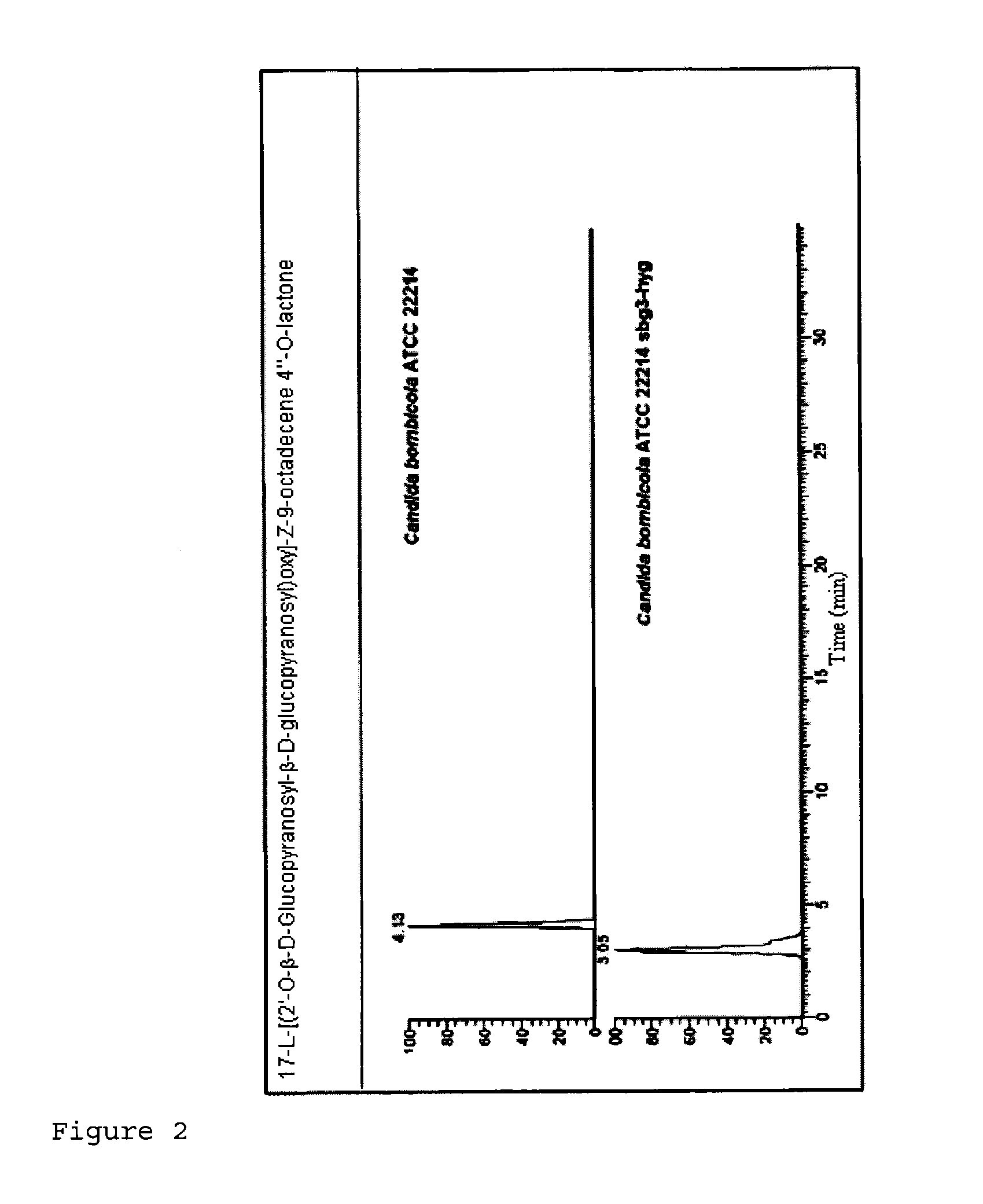Cells, nucleic acids, enzymes and use thereof, and methods for the production of sophorolipids
a technology of sophorolipids and nucleic acids, applied in the field of nucleic acids, enzymes and cells, can solve the problems that cells also have to be subjected to genetic modification, and cannot be achieved by optimizing performance parameters. achieve the effects of improving the degree of acetylation and the fatty acid species, reducing the number of fatty acid species, and improving the performance parameters of sophorolipid formation
- Summary
- Abstract
- Description
- Claims
- Application Information
AI Technical Summary
Benefits of technology
Problems solved by technology
Method used
Image
Examples
example 1
Generation of Uracil-Auxotrophic Mutants of Candida bombicola ATCC 22214
[0150]A uracil-auxotrophic mutant of Candida bombicola ATCC 22214 was generated as described hereinabove (van Bogaert et al. Yeast. 2007. 24(3):201-8). This strain was named C. bombicola ATCC 22214 ura−.
example 2
Inactivation of the Structural Genes of the Enzymes Involved in Sophorolipid Biosynthesis in Candida bombicola ATCC 22214
[0151]In order to be able to identify enzymes involved in sophorolipid biosynthesis, the genome of Candida bombicola ATCC 22214 was first sequenced by means of GLS Flex Titanium technology. Upon inspection of the genetic information of Candida bombicola ATCC 22214, a cluster of five genes (Seq ID No. 01) was identified whose coding regions (Seq ID No. 02, Seq ID No. 03, Seq ID No. 04, Seq ID No. 05, Seq ID No. 06) encode gene products (Seq ID No. 07, Seq ID No. 08, Seq ID No. 09, Seq ID No. 10, Seq ID No. 11).
[0152]The five genes were named SBG1 (Seq ID No. 02), SBG2 (Seq ID No. 03), SBG3 (Seq ID No. 04), SBG4 (Seq ID No. 05) and SBG5 (Seq ID No. 06) (SBG stands for Sophorolipid Biosynthesis Gene). They encode the following proteins: Sbg1p (Seq ID No. 07), Sbg2p (Seq ID No. 08), Sbg3p (Seq ID No. 09), Sbg4p (Seq ID No. 10) and Sbg1p (Seq ID No. 11).
TABLE 1Sbg1p, S...
example 3
Characterization of the Sophorolipid Formation by C. bombicola ATCC 22214, C. bombicola ATCC 22214 sbg1, C. bombicola ATCC 22214 sbg2, C. bombicola ATCC 22214 sbg3, C. bombicola ATCC 22214 sbg4 and C. bombicola ATCC 22214 sbg5.
[0175]The propagation of strains C. bombicola ATCC 22214, C. bombicola ATCC 22214 sbg1, C. bombicola ATCC 22214 sbg2, C. bombicola ATCC 22214 sbg3, C. bombicola ATCC 22214 sbg4 and C. bombicola ATCC 22214 sbg5 is done on YPD agar plates. The medium referred to hereinbelow as SL production medium is used for the production of the sophorolipids. It is composed of 0.1% KH2PO4, 0.5% MgSO4×7 H2O, 0.01% FeCl3, 0.01% NaCl, 0.01% uracil, 0.4% yeast extract, 0.1% urea, 10.5% rapeseed oil and 10% glucose. The pH is brought to 4.5 and the medium is then sterilized in an autoclave (121° C., 20 min). It is not necessary to adjust the pH during the cultivation.
[0176]To study the sophorolipid production in the shake flask, a preculture is first established. To this end, 10 m...
PUM
| Property | Measurement | Unit |
|---|---|---|
| volume | aaaaa | aaaaa |
| pH | aaaaa | aaaaa |
| volume | aaaaa | aaaaa |
Abstract
Description
Claims
Application Information
 Login to View More
Login to View More - R&D
- Intellectual Property
- Life Sciences
- Materials
- Tech Scout
- Unparalleled Data Quality
- Higher Quality Content
- 60% Fewer Hallucinations
Browse by: Latest US Patents, China's latest patents, Technical Efficacy Thesaurus, Application Domain, Technology Topic, Popular Technical Reports.
© 2025 PatSnap. All rights reserved.Legal|Privacy policy|Modern Slavery Act Transparency Statement|Sitemap|About US| Contact US: help@patsnap.com



